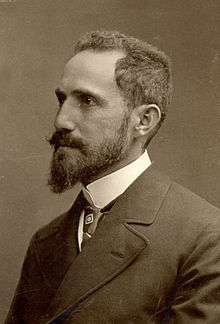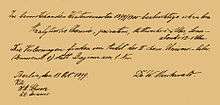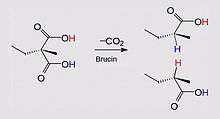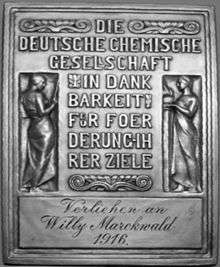Willy Marckwald
Willy Marckwald (1864, Jakobskirch, Germany – 1942, Rolândia, Brazil)[1] was a German chemist. He was nominated for the Nobel Prize in Chemistry in 1922 by Gustav Tammann and again in 1929 by Niels Bohr, Dirk Coster and George de Hevesy.[2]

Biography

Marckwald studied at Berlin's Friedrich-Wilhelms-Universität and received there from the First Chemical Institute in 1886 his Promotierung under A. W. Hofmann with a dissertation on organic chemistry entitled Beitrag zur Kenntniss der Thialdehyde und Thialdine.[3]
By his research on furans, Marckwald received his Habilitation[4] in a very short time in 1889 under the supervision of A. W. Hofmann at Friedrich-Wilhelms-Universität Berlin. In 1899 Marckwald became one of the department heads at the Second Chemical Institute.[5] He held this Privatdozent-level position until his age-related retirement in 1930.
From 1928 to 1931 he was the board chair of the German Chemical Society.
In 1890 Marckwald married Margarete Salomon (1871–1908). Their marriage produced two sons, Friedrich (1892–1917), who died in World War I as a naval aviator, and Johann (1902–1986). In 1936 Willy Marckwald, with his son Johann and his daughter-in-law Prisca, became immigrants in Brazil.
Scientific work
From the starting point of his Promotierung dissertation and Habilitation, Marckwald developed a wide interest in all the fields of chemistry of his era. In heterocyclic chemistry, building upon the research done on Gabriel synthesis, he developed a method for synthesis of aziridines from β-halogen-amines. This ring closure method, known as the Gabriel-Marckwald reaction, allows the preparation of heterocyclic amines that are n-membered, where n=3,4,5,6, or 7.[6][7][8][9] In so far as possible, Marckwald sold the patent rights for use in industry.[10] On this topic, he also wrote monographs of general interest.[11]
At the Second Chemical Institute, Marckwald did pioneering research on kinetic resolution and stereoselective synthesis.

Three of his outstanding achievements were:
- 1899, Kinetic resolution by synthetic means;[12][13]
- 1900, Methods for enantiomer separation by crystallization of derivatives;[14]
- 1904, Enantioselective chemical synthesis (Asymmetrische Katalyse).[15]
At the Second Chemical Institute under Landolt's direction, Marckwald beginning in 1900 turned increasingly toward theory[16] but also to the inorganic chemistry of radioactive compounds. He collaborated on Landolt's sections in the textbook Graham-Otto's ausführlichem Lehrbuch der Chemie. From 5 metric tons of uranium ore, in 1902 Marckwald succeeded in isolating 3 milligrams of polonium, which he provisionally (vorläufig) named radio-tellurium.[17][18][19][20] In 1904 he published a monograph on radioactivity.[21]
Marckwald has worked up the crude tellurium obtained from about 15 tons of pitchblende. By dissolving the material and precipitating with sulphur dioxide, about 16 g. of a mixture of selenium, tellurium and radio-tellurium were obtained. Upon oxidizing this with nitric acid, evaporating to dryness and warming with a solution of ammonia, a residue weighing about 3 mg. was obtained, which apparently contained practically all of the radio-active material, and possessed "enormous" activity.[22]
In 1911 Marckwald and Alexander Smith Russell published evidence suggesting that the radioactive thorium isotope 230Th and ionium are identical.[23]
Honors and awards

- 1916 — special honor from the German Chemical Society
- 1919 — appointment as honorary professor of inorganic chemistry at the Königlichen Technischen Hochschule Charlottenburg[24]
References
- Guide to the Willy Marckwald Collection, 1931-1934, AR 10156. Leo Baeck Institute Archives. Center for Jewish History
- Willy Marckwald, Nomination Database, Nobelprize.org
- Inaugural-Dissertation "Beitrag zur Kenntniss der Thialdehyde und Thialdine", results published as Ueber Zersetzungsprodukte des rhodanwasserstoffsauren Thialdins, Ber. dt. Chem. Ges. 19, 1826 (1886) & Ueber das Methylthialdin, Ber. dt. Chem. Ges. 19, 2378 (1886).
- Marckwald - Publikationsübersicht 1888–1896
- Historie II. Chem. Institut: Vorstand (chief executive) to 1891 Carl Rammelsberg, 1891–1904 Hans Heinrich Landolt, 1905–1923 Walter Nernst, from 1923 Max Bodenstein. - Bunsenstraße 1, Berlin. In 1905 the Second Chemical Institute (II. Chemische Institut) was renamed the "Physikalisch-Chemisches Institut" (the Institute of Physical Chemistry).
- S. Gabriel: Ueber Vinylamin. In: Ber. dt. chem. Ges. 21, 1049 (1888)
- C. C. Howard, W. Marckwald: Zur Constitution des Vinylamins. In: Ber. dt. chem. Ges. 32, 2036 (1899)
- W. Marckwald: Ueber das Dimethylenimin. In: Ber. dt. chem. Ges. 33, 764 (1900)
- W. Marckwald, O. Frobenius: Ueber Verbindungen aus der Aethyleniminreihe. In: Ber. dt. chem. Ges. 34, 3544 (1901). doi:10.1002/cber.19010340346
- US-Patent Nr. 500665: Verfahren zur Herstellung von Piperazin, angemeldet 26. Mai 1892, Nutzungsrechte Chemische Fabrik auf Aktien (Schering)
- „Ueber die Beziehungen zwischen dem Siedepunkte und der Zusammensetzung chemischer Verbindungen welche bisher erkannt worden sind“
- W. Marckwald, Alex. McKenzie: Ueber eine principiell neue Methode zur Spaltung racemischer Verbindungen in die Bestandtheile. In: Ber. dtsch. chem. Ges. 32, 2130 (1899).
- Stewart, A. W.; Graham, H. (1908). Recent Advances in Organic Chemistry. Longmans, Green and Company. pp. 40–41.
- W. Marckwald: Ueber die Trennung der Amylalkohole des Fuselöles. In: Ber. dtsch. chem. Ges. 34, 479 (1901).
- W. Marckwald: Ueber asymmetrische Synthese. In: Ber. dtsch. chem. Ges. 37, 349 (1904).
- „Die Benzoltheorie“ von W. Marckwald, 1898
- Die 14. Hauptversammlung der Bunsengesellschaft. In: Polytechnisches Journal. Band 322, 1907, Miszelle 1, Seite 364.: „3 mg Poloniumsalz aus 5.000 kg Uranerz“.
- Sieghard Neufeldt (2012), Chronologie Chemie (in German), John Wiley & Sons, p. 115, ISBN 352766284-7
- Marckwald, W. (17 March 1904). "Radio-tellurium". Nature. 69 (1794): 461. doi:10.1038/069461a0.
- Quinn, Susan (1995). Marie Curie: A Life. p. 173.
- „Über Bequerelstrahlen und radio-aktive Substanzen“. Moderne Ärztliche Bibliothek, Heft 7 (1904)
- "Radio-tellurium". The American Journal of Science. s. 169–170: 324. 1905.
- Lind SC; Whitemore CF (1914). "The Radium : Uranium Ratio in Carnotites". Journal of the American Chemical Society. 36: 2067. doi:10.1021/ja02187a010. hdl:2027/uc2.ark:/13960/t5v699p3j.
- Technische Universität Berlin: Sammlung anorganischer Präparate - Anorganisches Laboratorium. - Vorstand Karl Andreas Hofmann befasste sich mit radioaktiven Stoffen.